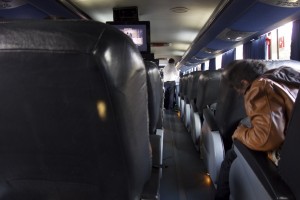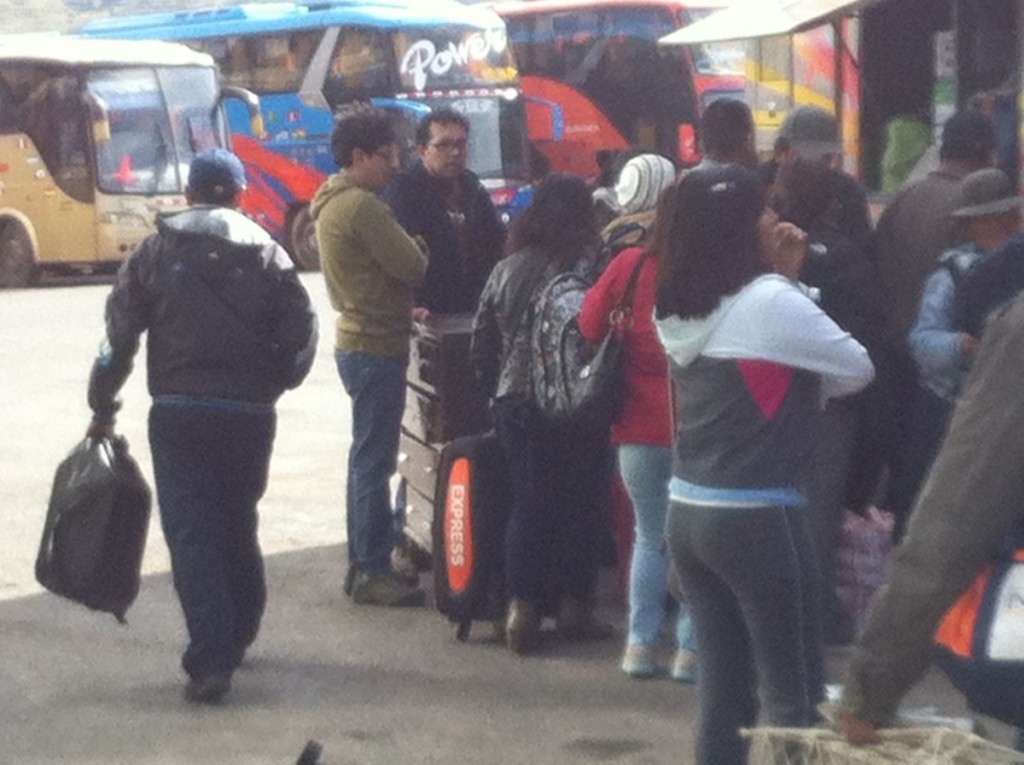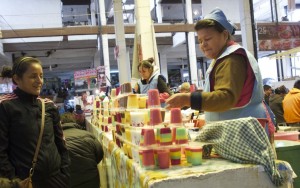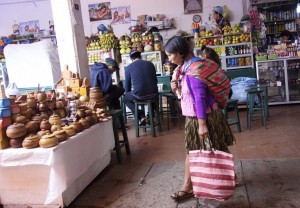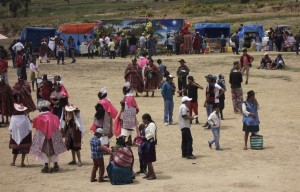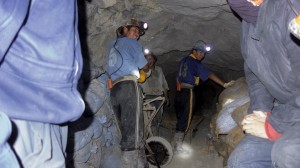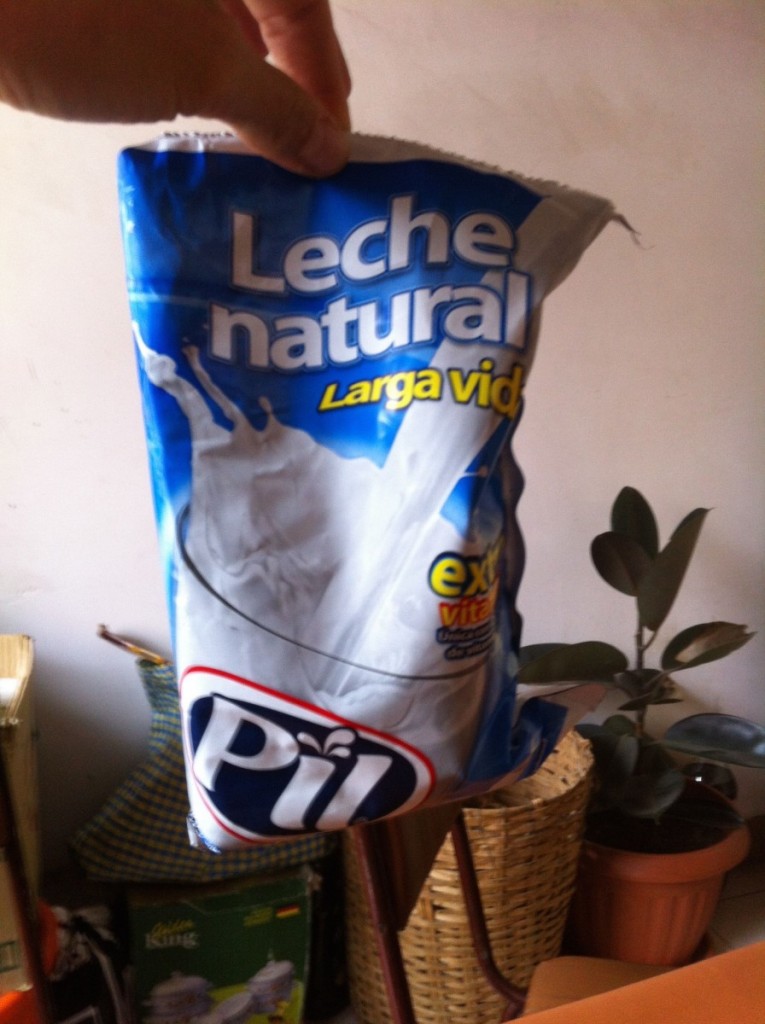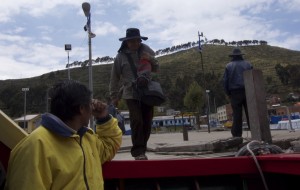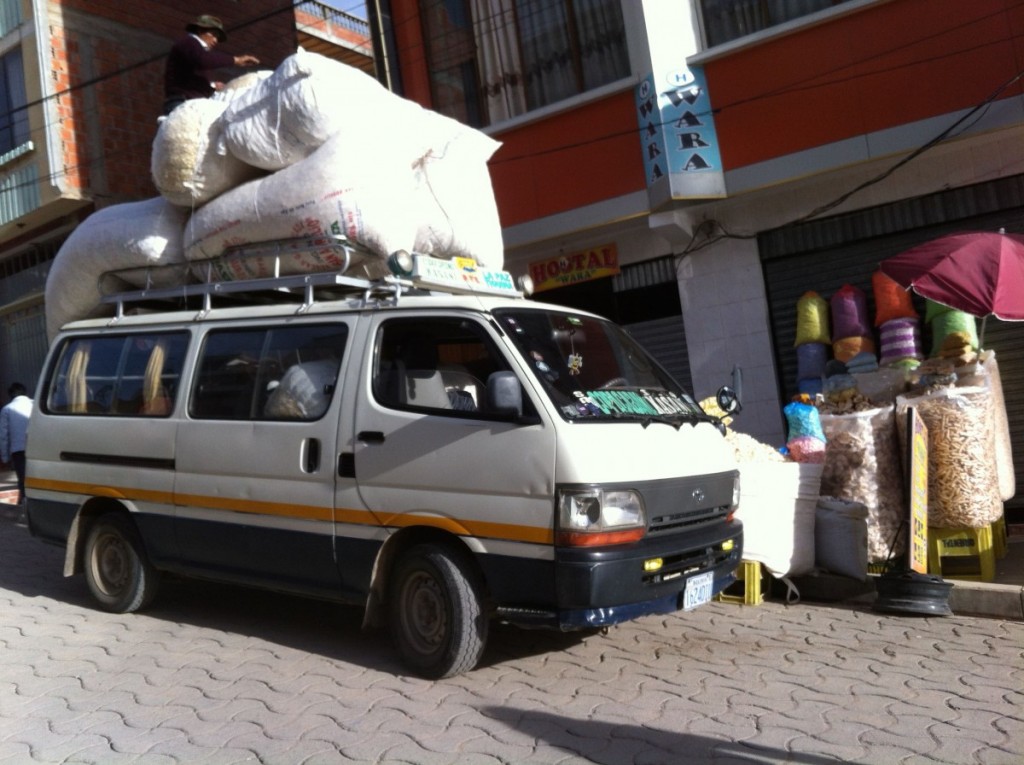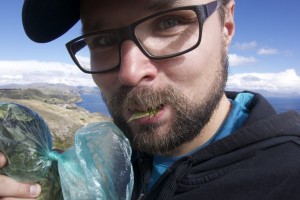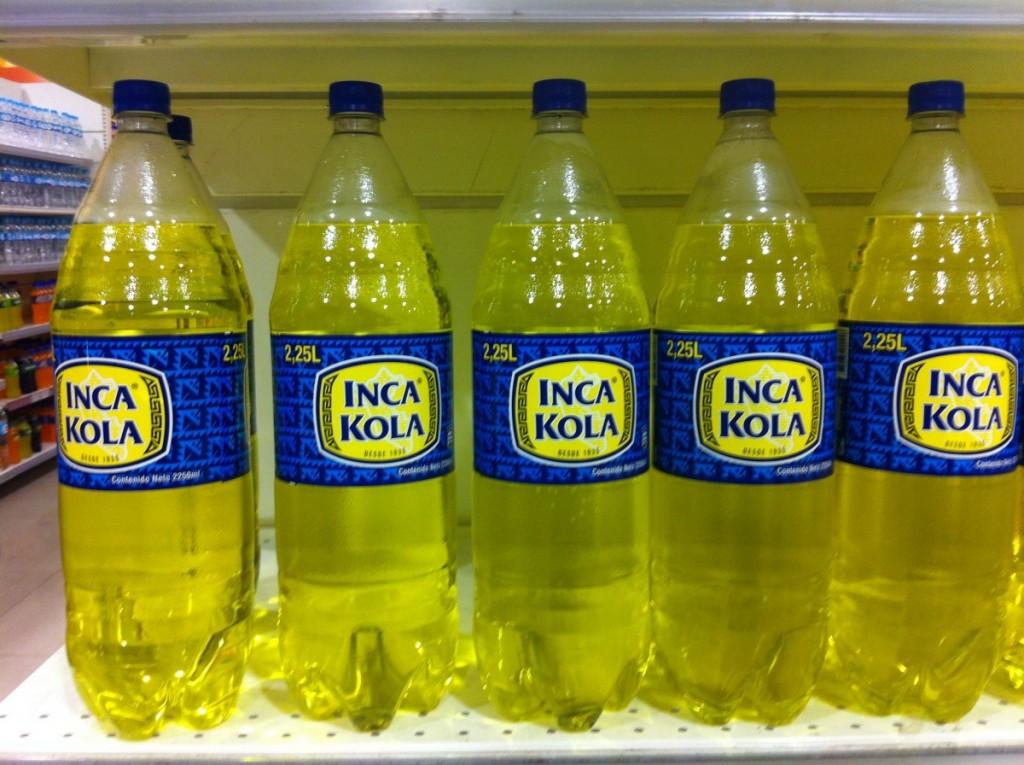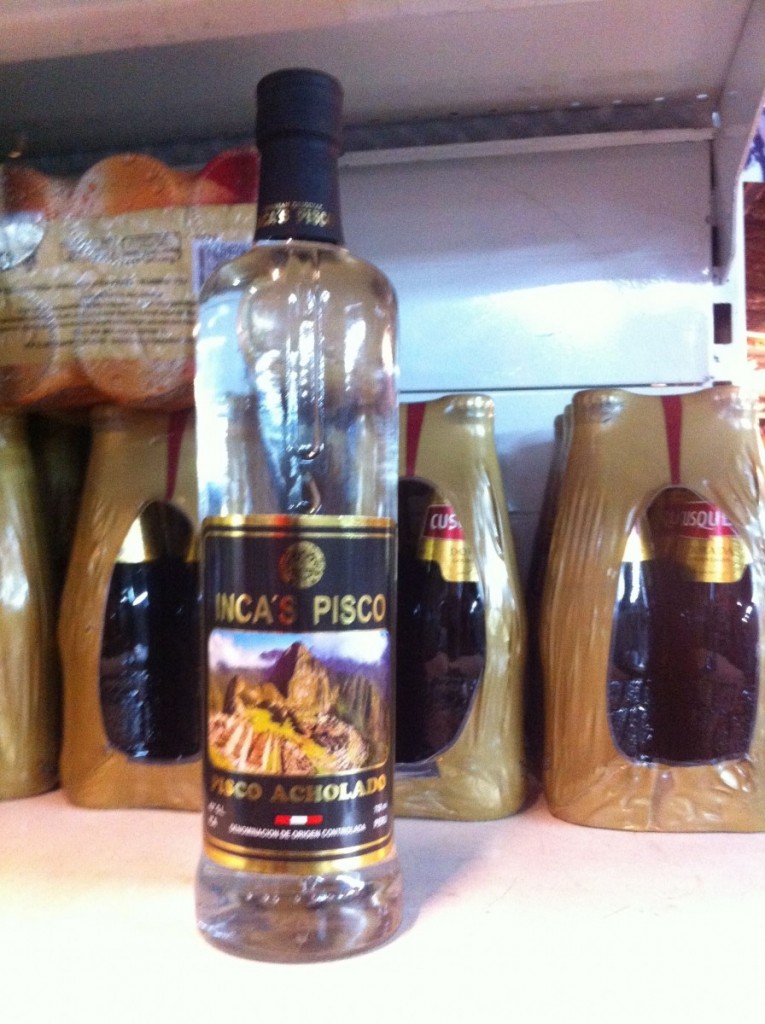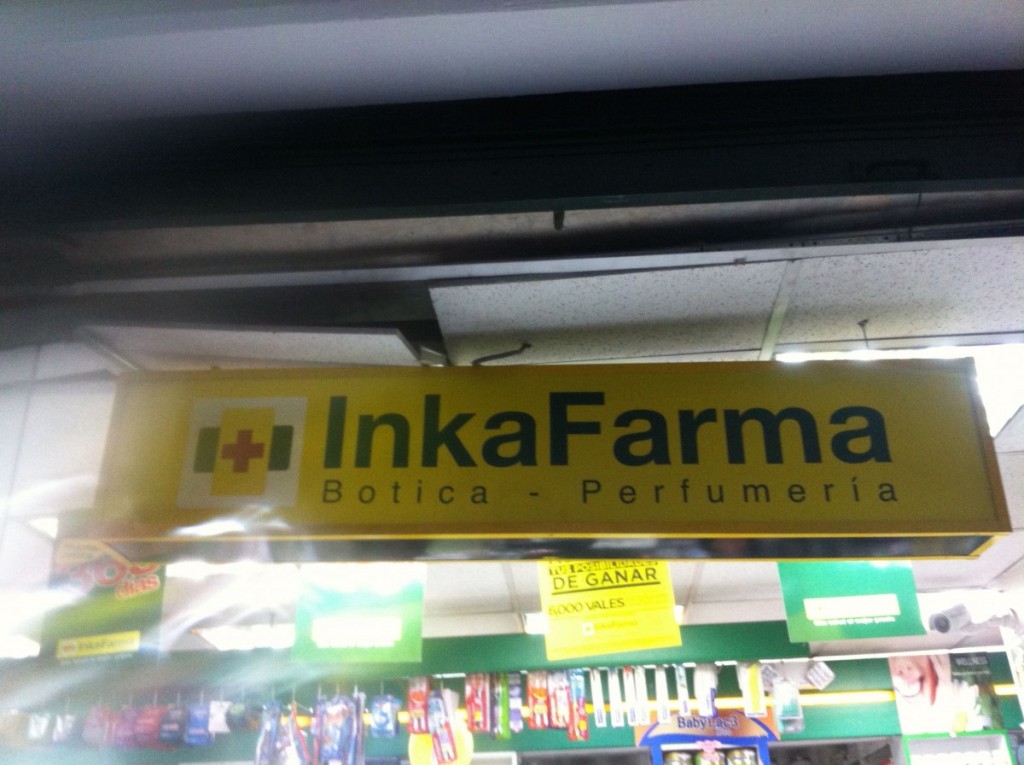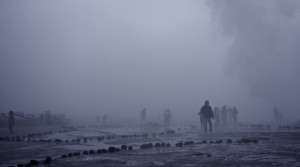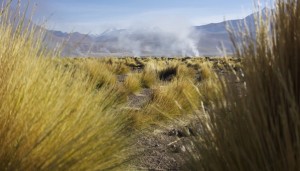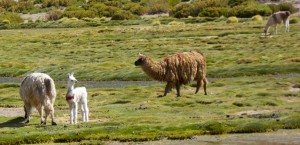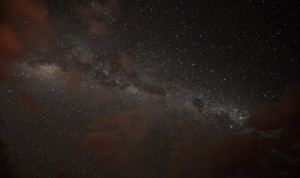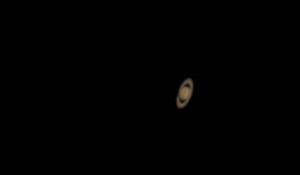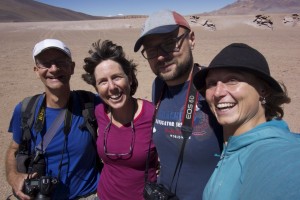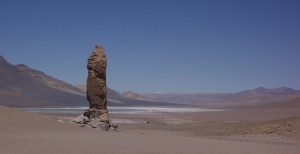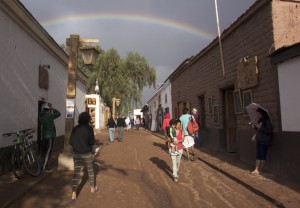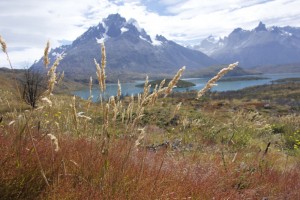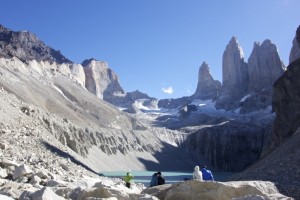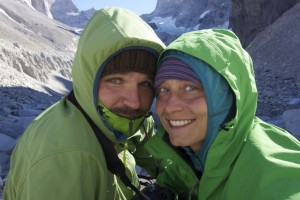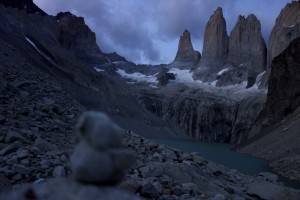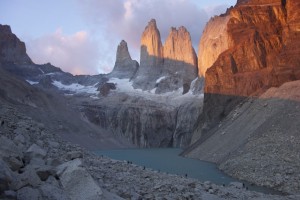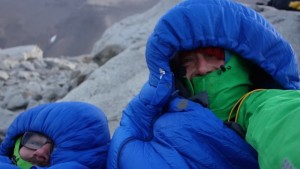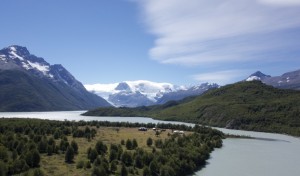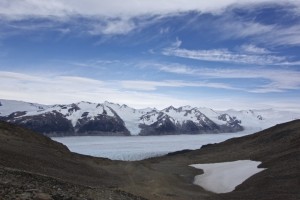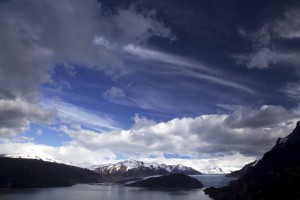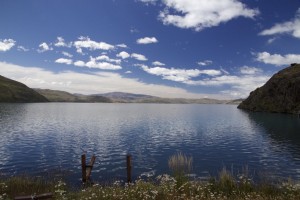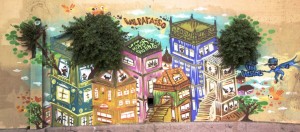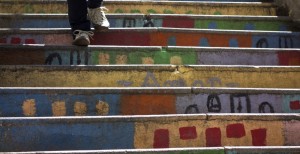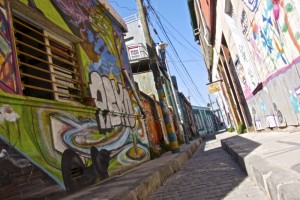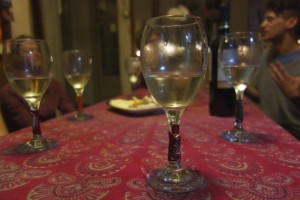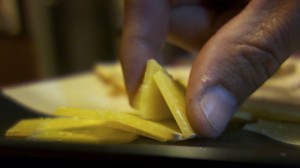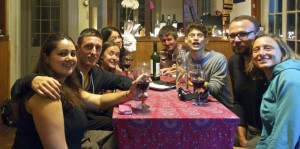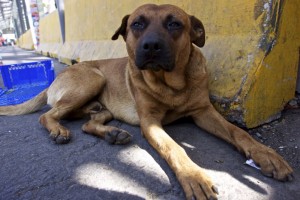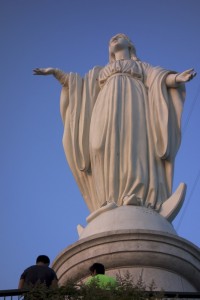The way to travel around South America are busses! You can fly, but it’s usually only affordable within one country, if at all. Interestingly bus fares and bus standards vary widely between countries even if you only take into account tourist busses.
Archiv der Kategorie: Chile
Lessons learned about South America
Many funny things we observed in south america don’t differ so much between the countries you will get the whole collection in one rush.
Chile and Argentina, both somewhat influenced by the europeans since a few centuries kind of similar. Both countries have an amazing landscape (we only saw Argentina’s close to the chilean boarder), produce good red wine (Argentina’s is a bit better) and speak a strange version of Spanish.
1. Chilean love sugar, so much that they even sell sugar light in supermarket to reduce calorie consumption.
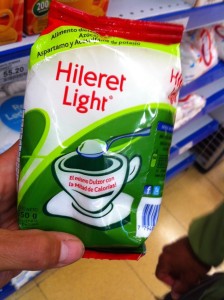
2. Chliean love color, especially in yoghurt. However the only seem to use one kind of color. Independent from the flavor all are bright pink.
3. There is no bargaining in Chile, not even on the markets. So you actual never feel cheated, but prices are higher than in the rest of South America.
4. Chilean don’t seem to have a sense of weight. While everybody tries to reduce weight while hiking, they even carry 1.4 kg heavy cookers around.
5. Steak is so popular in Argentina that the only kind of knives in Hostels are actual steak knives. It gave us a hard time to spread the butter on bread.
6. Argentines love their dulce de leche (some weird mix of caramelised milk and sugar) and put it into everything. I don’t like it but since it’s usually very brown I regularly misjudge it as chocolate.

I find it quite significant that the ice cream shop offers two kind of chocolate but four kind of dulce de leche ice cream.
7. Argentina is surprisingly expensive. Knowing about the unofficial dollar blue rate of 12.5 compared to the official 8.7 really saved us some money.
8. Argentines have a great relation to plastic bags. Every single person in the queue in front if me brought a fabric bag to carry their groceries home.
9. Siesta is still written in big letters in Argentina, causing two stupid looking persons in front of a supermarket more than once.
10. This is one for Nanna. Argentines are wild with Fernet, mostly Fernet Branca. They drink it for every occasion and mix it even with coke.
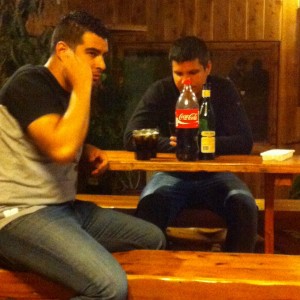
11. We never figured out for which reason but ham and cheese are really popular ingredients in the Chilean and Argentina cuisine. You get it with the scrambled egg in the plan, on sandwiches, in empenadas, on top of what they call Milanesa (in principle Wiener Schnitzel) or just pure.
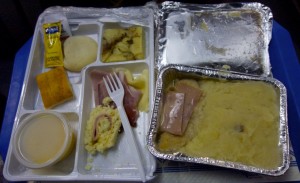
12. Chileans knock on toilet doors. What a great habit, than just pushing down the toilet handle.
13. Surprisingly Argentina is the first country that really did something against plastic bags, so most people actually bring fabric bags for shopping. I like!
14. Despite the fact, that coffee is produced in south america they don’t really nurse a coffee culture. Most just dink freeze dried coffee with lots of sugar. but I kind of like the teabag version. Really handy in busses.
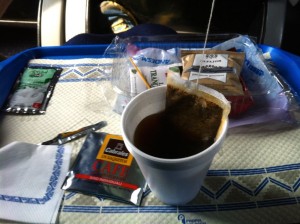 15. Of course they love soccer and are so proud. Even the screens in underground stations allow you to keep track off the doing of your favourite team.
15. Of course they love soccer and are so proud. Even the screens in underground stations allow you to keep track off the doing of your favourite team.
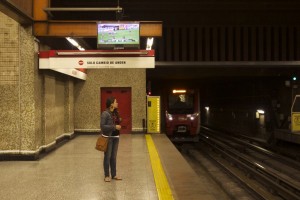
Bolivia is so very different form Chile and Argentina. It’s characterised by the Andes (that maybe the european settlers just didn’t bother to cope with) and what they call the andean folk.
San Pedro and it’s Tours
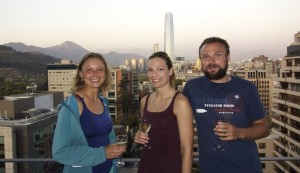
After a short stop in at Kristin’s in our favourite south american city we headed off north to San Pedro the Atacama.
At the time of visit 63 travel agencies, running the most popular tours, were located in the town. Some destinations can unfortunately only be reached by a tour so we had the great fun of picking some that hopefully wouldn’t at least kill us (several dangers lay in front if us: altitude sickness, boiling geysers, unpaved roads, the simple fact of being in a desert and the likeliness of a drunken driver somewhere in Bolivia). We chose based on tripadviser and a funny/creepy book to be found in the tourist office if SPDA (Sam Pedro de Atacama) collecting complains and praises of travel agencies in town.
Some questions you would want to keep in mind will talking to any tour operator: Which tour company is it? How Many thanks to Tom apeople are going to be on the tour? Does the guide speak English? How long does the tour last? How much time are we going to have at the POI? What does the tour include? Are there extra fees to be paid? Is water included in the tour? What do you have to bring? Do the driver drink alcohol?
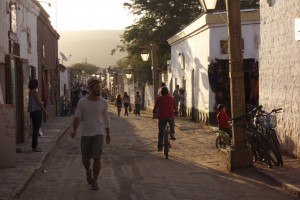
Roaming the main street of SPDA. You will find a few locals, many tourist, 63 tour operators and even more eateries (quite good and cheap though), many hostles and lots of sand.
It’s 4:30 in the morning. Busses of all sizes are roaming the through the streets of clay and sand. Tourist are squatting in front of every hostel desperately watching bus after bus go by until at one point one is stopping and feeding them into its belly and heads off to the mountains.
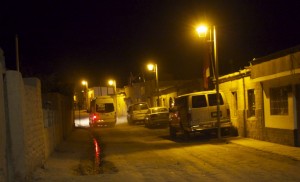
It’s 4.30 in the morning but the streets are busy with tourist and minivans. Get the feeling everybody booked a tour for this day.
The advise from Paco against altItsitude sickness was to breath slowly and deeply and wait for your brain to tell the body what to do. And of course chewing coca leaves. It’s perfectly legal in Chile but don’t try to pass a drug test soon after.
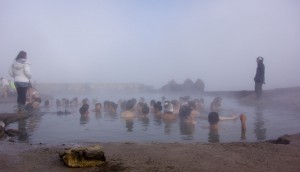
Tom got me to go in there despite the freezing temperatures outside. I regretted it immediately. Cold, slimy and my skin started itching right away.
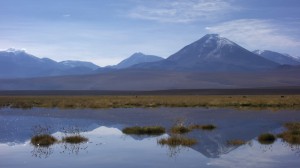
A volcano relfecting it self in a puddle of water (we found quite a lot water around here, despite the fact being in a desert).
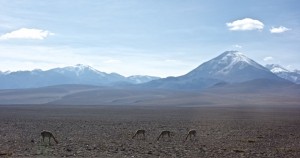
Vincunas, the desert lama. By now they are protected in Chile and only a few people have the licence to cut the fur and use it for handicraft for tourists, of course.
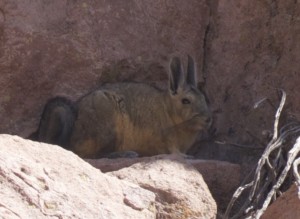
Viscachas are pretty shy, so we were pretty lucky to see one. To me it looks a bit like a mix of rabbit and guinea pig („Meerninchen“ in german).
The next morning (rather night) at 3:40 we were picked up by Jorge to do what Tom said he wanted to do. Watching the stars. Jorge explained us quite a lot about the southern sky and astronomy in general. Let us play with his telescopes and pointed out stars and planets for us (we saw Jupiter and it’s moons as well as Saturn) which was really amazing and paid of for the lack of sleep.
You could probably spent several weeks here enjoying this incredible landscape but we just had time for one more small trip with Tom and Jeanette from Canada. The took us up to the salt flats and insulting rock formations around San Pedro including a some acclimatization time at 4600 m. Time just flew by while chatting in their car and soon our last day in San Pedro was over. After a finally a refreshing sleep of 8 h we headed of for Salar de Uyuni the next day.
Around los Torres
The journey from Santiago to the National Park Torres del Paine was quite a long one. Getting up 4 am to take the bus to the airport were a plane (I still think it was one that easyjet discharged.) took us to Puerto Montt and then to Punta Arenas. From there we wanted to take the shuttle bus to puerto natales, the harbor to Torres del Paine. Stupidly enough you have to pre-book this bus which we didn’t. So we ended up taking the shuttle bus to Punta Arenas. Arriving there we were told all buses to Puerto Natalas were booked for the afternoon. At least we found one taking us there at 6:30 pm and we used the time to eat the last greasy Chilean meat for the next days.
Since we planned on a 8-9 days hike on the track around the Torres (tower) of Paine (Paine is the river in the National Park) we stocked up our supplies in Santiago to cover for the calories that we are going to burn during the next days. For the complete list see below.
Essentials 392 kcal coffee 910 kcal coffee mate (coffee whitener)
Breakfast 2665 kcal Müsli 1984 kcal milk powder 2143 kcal instant oats 778 kcal oats 117 kcal cornflakes 1152 kcal almonds 748 kcal rasins
Lunch 6006 kcal Wraps 250 kcal bread 960 kcal rolls 3007 kcal Salami 3103 kcal cheese 632 kcal coca cola 750 kcal ice creme 3125 kcal peanut butter
Dinner 1800 kcal Couscous 416 kcal tuna 480 kcal avocado 372 kcal butter 1156 kcal rice with champions 1104 kcal rice chicken 1112 kcal Asia instant noodles 369 kcal pumpkin soup 343 kcal broccoli soup 2052 kcal pasta 389 kcal bolognese sauce 680 kcal red wine
Snacks 768 kcal gran cereal bars 636 kcal trailMix bars 1610 kcal snickers 545 kcal chocolate 1020 kcal muffin max bars 606 kcal cookies 869 kcal creme 620 kcal milk
This gives a total of 45669 kcal for 8 days of hiking meaning 2854 kcal per day and person. We were never hungry, but we could always have eaten more.
Day one
Started just a little hectic. We needed some more money, the last packing and finally some breakfast before we jumped on the bus at 7:30 am. The view at the bus station was awesome. From every direction little Trekkers (terrercitos in spanish) were approaching the bus station and filled up numberous busses to be shuttled to Torres del Paine including us.
I am sure the bus ride was breathtaking but I slept most of the time until the 4 step entry process:
1. Filling the form with you details and the commitment not to destroy the park
2. Pay the fee (18.000 CLP ~ 25 USD)
3. Get a stamp from the ranger
4. Watch a 3 min movie about what not to do in the park
And then you are ready to go. Most people start their trek from here. We anyway took the bus to the western end of the park and hiked the 2 h to the tiny campsite las Carretas (no free camping in the park).
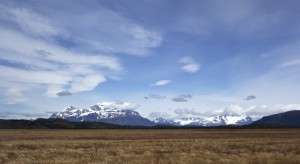
The first scenic view on day one of nine. Wherever you are in the park the scenery is rarely hidden by trees.
Day two
Started a lot later. We wanted to get up at 7 but first made it to 8:30 am. It’s really no wonder so many people come here. To me the most beautiful thing is actually the view you have constantly. Now trees blocking the sight of the rushing glacier rivers, lakes and snow capped mountains.
We arrived at the campsite of the day we found our neighbors to a little family hiking the W in 7 days. Pretty amazing considering the fact that their daughter is three years and their son four months old.
Day three
Meant leaving the tent behind and hiking up „Valles Frances“ not knowing what was waiting at the end. The soundtrack was composed by the several avalanches coming down the glacier right next to us. Unbelievable how small they seem and how much noise they make. Anyway you will only see them when you look for them, when the sound waves finally reach you the avalanche is already gone.

And this is what was waiting at the end of Valle Frances. A long chain of mountain peaks. One man was enthusiastic enough to name every single one to his wife, who was more interested in her cheese sandwich.
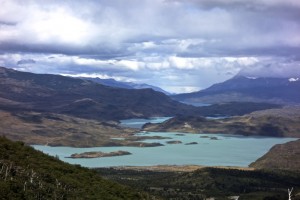
View of Lago Nordenkjold from Valles Frances. Wonder which norwegian had his finger in the pie of giving this lake a name.
Back on the campsite we hauled the heavy bags again on our backs and headed off for the next campground (this one charged us 15 USD each but at least offered hot showers :)).
Day four
Started with rain pouring down, so despite an early rise we decided to take it slow an prolonged our breakfast until it stopped half past nine (how wise ;)).
The path went along the mesmerizing blue lake until during a long left turn it went up the hill and up the hill. We reached Campamento Torres at 4 pm time enough to went up to the rock formation that gave the park it’s name. And who wouldn’t in this perfect sunshine. Alone our legs were moaning about the steep ascent, but getting around the corner and suddenly see the mountains „tower“ above a small mountain lake is paying off every step.
Day five
Started really early, and when I say really early I mean 3:30 am. We boiled water for coffee grabbed sleeping mattress, sleeping bag and the pre-prepared wraps and headed off for the towers a second time in complete darkness (I was really glad we did the track the day before because it got even trickier in the dark.).
5:15 wrapped in several layers of clothing and with a coffee in the hand we waited for the sun to rise. It should take another hour before the tower gleamed in red light. By that time the strong winds had cooled us down to freezing and we stopped taking pictures and crawled in the sleeping bags to just enjoy the view and escape the wind.
Then we made us on the long descent with a hotel, little kiosk and ice creme waiting for us at the end. For the last four hours of the day we pimped us with sugary calories that fueled us for ten of the twelve kilometers before we finally hit the wall feeling that it was a long day. 1.5 peanut butter wraps later we arrived at the lovely Campamento Seron. The only real low point, there is no cooking shelter making cooking in this windy conditions a real challenge.
Day six
Meant walking through endless Daisy fields surrounded by the river Paine and chains of different colored snow capped mountains.

Thousands of daisys teem with the icy antarctic wind giving this side of the park a very idyllic face.
Our first expirence with the real Patagonian wind waited one hour behind the campsite on top of a little hill. The valley here us so windy it’s blowing the snot out of your nose. In a constant up and down through more daisys we made out way until we saw from a little cap camp Dickson in the edge if a lake having the glacier Dickson in its backyard.
Day seven
Was an uneventfull and short day hiking through the green woods along a rushing river that was finished off by some hours if relaxed reading in the tent and eating :).
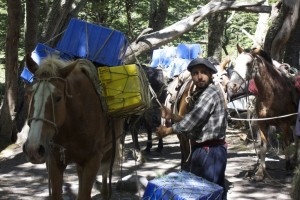
Here we learned how all the supplies of beer, wine and chocolate reach the remote campsites, by horse and gaucho. No further complaints about cold showers.
Day eight
Turned out to be a bit too long for us. We got up early to go over the John gardener Pass that separated us from the last bit of our trip. We were surprised how easy we proceeded and how less wind there were (supposed to be very windy!). When we arrived at the top of the pass we were hit be the enormousness of glacier grey waiting for us on the other side spreading out over dozens of kilometers.
The next hours we hiked along the glacier with ever new points of view. When we arrived at the next campground it was still early so we decided to walk another six kilometers to the next one, just after six kilometres there was no campground. The last four k became very long which we only survived on an extra wrap and more snacks. Therefore the day was celebrated in the evening with wine and cookies from the shop at Campamento Grey.
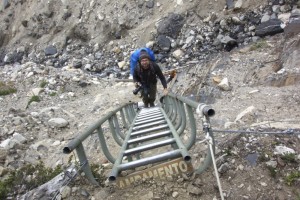
The last four kilometres were a good up and down, but we were not prepared for the climb through valleys on water pipes.
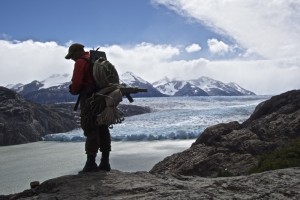
A few years earlier a bit part of the park burned down due to a camp fire that got out of control. Since then camp fires are prohibited and fireman train more regularly. But seriously, they are not very fast hiking with their water tubes.
Day nine
Was going to be our last day. A leisure hike offered some views if the glacier lake (rock walls blocking it most of the time) and than around the corner there was already the small landing for the ferry bring us back to the bus station and back to beds, vegetables and endless supply of hot water.
It’s a truly wonderful hike, even tough it gets quite busy during high season. At least my pronunciation of ‚hola‘ was perfect after greeting hundreds of trekker.
Valpo on 45 hills
Valparaiso or short (Valpo) is just a short 2h bus drive from Santiago and Busses go every 15 min. So we left our hiking stuff behind and traveled lightweight to this colored city by the sea side. The city is quite exceptional distributed over 45 hills that are connected by ancient elevators and rainbow colored stairs.
We were adviced that there are some hills that we certainly don’t want to go to, but actual we didn’t felt threatened at any point. It’s nearly impossible to walk around between the painted houses and not just be amazed by the beautiful pictures that decorate most of the walls. Street art is actual illegal in whole chile, but if the owner of the wall (and even the city itself) gives the permission it is okay to paint in them. So many street artist come here to life and paint. Unfortunately also many other people own spray cans and leave their tags (signs) on our next to the paintings. You can probably walk around in ages and discover new paintings every time (since many artist are still very young they will hopefully continue painting for many years).
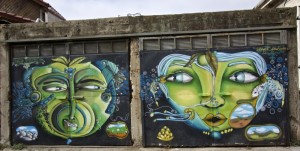
The couple „color distinto“ and their elaborated paintings changed the view on graffities and the face of Valparaiso substantially.

But also many other artist leave their traces over the city, working together they create pieces like this one.
Aside from that Valpo is absolutely a place to enjoy life. On our first night we attended a wine tasting organized by a guy from our hostel were we came to try many different Chilean wines and cheese and chatted with other guest from our hostel, so even the tasting was over we kept on drinking beers on the plaza in front if our hostel listening to the street music until 3 am. This also led to a very late breakfast the next day so all we managed to do was to attend the free walking tour before we ended up on the plaza again eating the Chilean version of a hotdog and drinking beer again.
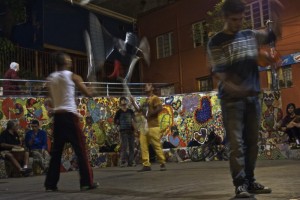
When we arrived at the Plaza Descanso in front of our hostel it just started to get to life with artisits and musicians, so we got more beer and settled for a few more hours.
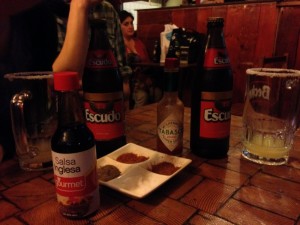
Drinking beer in chilean. You get a glass filled with some lemon juice and its rim covered in salt. Then you add the beer and spices as you like. The first sip is weird but it get continously better.
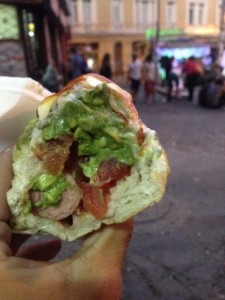
The chilean version of Hotdog comes with huge amounts of fresh tomatos and avocado topped with ketchup and mayonese.
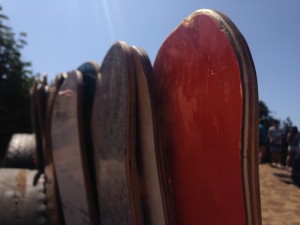
The sandboards are hardly more than a painted wooden board with straps. To wax it (which you have to do every 30 m) you get an old piece of candle.
So we had two choices stop drinking beer or extend our stay. We extended the stay to five nights so we had the time to go sand boarding, taking a boat tour, learn even more about graffiti, and dance to the drum music on our favorite plaza (we stopped dancing at 2 am, unfortunately they kept playing until 8:30 am so there wasn’t much sleeping that night).
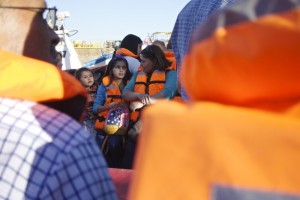
We didn’t got a word of what the guide was telling us, but he made sure we were all well prepared for the 30 min ride.
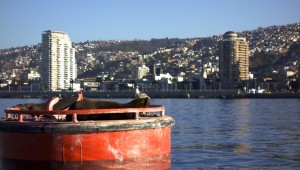
We also met some of the marine locals of Valpo. They didm’t even bothered to turn there heads to us.
Overall Valpo is a really fun but very exhausting place. Absolutly recommendable.
Santiago – Warzaw in Chilean
Landing in Santiago promised quite a change from NewZealand. The view from the plan revealed a yellow-brown dry landscape. And yes temperatures finally allowed to retrieve the short thoursers from the bottom of the backpacks again.
Anyway, in a very nice way many things reminded us of Warzaw. The heat, the parks, people on city bikes, the straight forward working underground train, and the funny and informative free walking tours around the city.
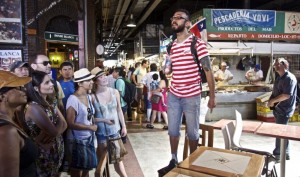
Carlos alias Wally guided us around the corners of Santiago, that you probably will miss on your own.
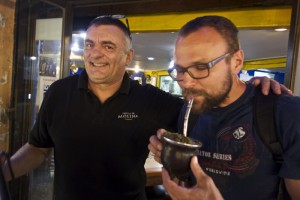
Tio Willy (located in the fish market) made Tom trying his first real Mate, not this sweet Club Mate stuff he is drinking back in Germany.
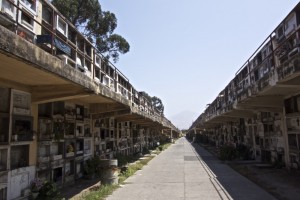
The tour led through Santiagos cemetry, which is as big as 117 soocer fields so you can easily get lost here.
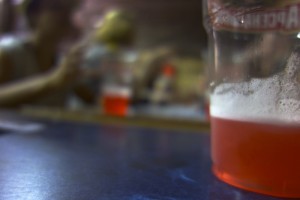
Finishing the tour with a drink is quite a nice style and after all the talk about earthquakes in Santiago a „Terremoto“ is the obvious choice. Made of Vino pipeño with pineapple ice cream the second glass makes the earth shake in deed.
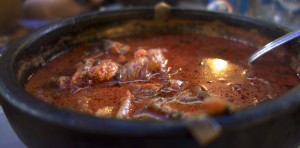
And then we headed back to Tio Willy to try some of the famous fish. I head soup made from conger eel.
A substantial difference in Santiago from Warzaw however were the huge number of stray dogs. They are just everywhere and some even adopt a lordling, as the one following our guide around the city. Though we never met one being aggressive towards us.
Christoball (the mountain with the virgin on top) was quite close to our hostel so we made it up there almost twice. On our second time the top was closed due to the fact that it was close to sunset and people get robbed there when it’s dark. But aside from all the stories you hear we felt pretty save in Santiago. When I lost a 5000 CLP note in the underground train a girl even came after me handing it back.
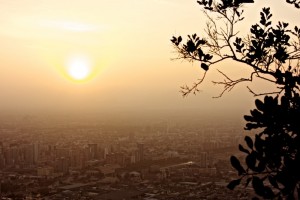
The view from christobal during sunset unfortunately reminds a little of china. The smog hanging over the city is reaching as high as the surronding mountains.

